Bakeng Duce: Enlarged Windscreen
By Bill Evans, EAA Chapter 266, EAA 794228
May 2020 – You may be questioning the spelling of Duce. It turns out the later spelling, Deuce, was only adopted when the rights changed hands in 1999, and specifically refers to aircraft built after that time. Duce is the correct spelling for C-GPLL, which was built in 1982, and that is as it appears on the certificate of registration. — Ed.
Perhaps five years ago, the phone rang with someone asking me to buy his friend's Bakeng Duce. The airport was sold, and if no airplane sale, then the chainsaw. Tube and fabric fuselage and wood and fabric wings. Never thought I'd own a wooden airplane. The furniture in the wings is nicer than the furniture in my grandmother's parlor. It followed me home like a stray cat. A gift really. But I digress from the windscreen.
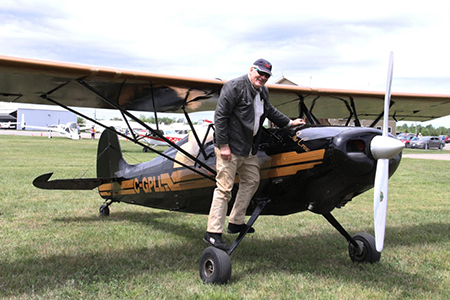
The author with his Bakeng Duce C-GPLL.
My Sonerai was stored in a hangar with someone else at Cornwall, so Harvey Reid and I drove together to Wyndover to inspect the Duce, and I subsequently flew it back to Cornwall. The purchase is a story in itself. It had not been in license for a while, so the technical counselor came up with a flight permit so we could fly south (Cornwall) and then do the inspections necessary to get it back in license. That also is another story and a funny one, but I digress.
At the time it needed a new turn coordinator, which saved several pounds and two venturi heads. A third story for the future. The point is that in addition to being the very easiest aircraft to fly, a Duce seems to require an annual inspection and very little else. The compressions are good. The tires and brakes show no wear on turf. It flies happily all season long. It also comes with a sliding canopy and three skis, but that is beyond me, probably.
The Problem
Normally the Duce is flown with a windscreen. That windscreen was perhaps 4 inches too short to protect my forehead. In truth, the airflow buffeted all around my head. So I'd fly it at 75 or 85 mph, but after an hour the turbulent air would still make me glad to land. A 90-minute trip was a big deal. Passengers in the front seat hated flying at 75, and some complained, so I investigated canopies. For some reason, the front seat is not so affected by turbulent air?
Two of my friends have summer places in adjacent provinces. Bob is near Digby, and Harry just bought a waterfront spot near Thunder Bay from the cartoonist Lynn Johnson. Even at 135 mph, both places are more than 90 minutes, I fear. But invitations have been extended. The Duce needs more speed. Digby is about 3and a half hours away.
When March began to look like spring, I felt that with the new cowling underway for the Sonerai II, I needed to make the Duce more flyable and add to its legs, and its flying season. Last year the turf was firm in April. A better windscreen might mean a flying season from April to November. That's quite a change from June to September. Twice the flying season.
The Bakeng website shows a canopy model they offer, but it is for the newer Deuce and does not fit mine. Neither will it close over my head; I'm 6 feet, 4 inches. Other companies offer to make canopies, but I got nowhere with them and a custom canopy might cost thousands. Yes, you can make one. A chap I know used compressed air (1 psi) and blew say five of them. He's not sure whether any are usable or not. With either air or vacuum, one might spend $10,000 before getting a perfect one. It's not for me.
Windscreen Front
That led me to do a closer examination of the existing six-pane windscreen. The three aft panes are hinged and easily come off in the hottest weather. The existing Lexan panes slide into slots on two to three sides and are bolted between aluminum strips on the open side. Thus removing the three panes takes but a few minutes. There are three front panes in narrow frames. The left and right sides are basically triangles and the center pane is, say, square. In fact, the bottom edge of those three panes is curved to fit the top of the fuselage.
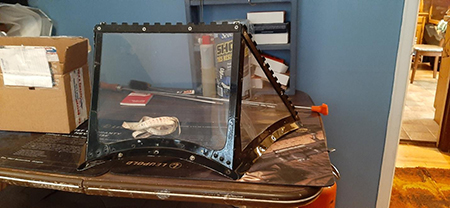
The original windshield.
I found that if all three panes are removed at once, the frame is so floppy you can't work with it, so I'd remove the panes one at a time. The original windscreen was 8 inches high. After a few trips to the plastics store and to the hangar, I decided on 18 inches. Lexan comes in that size, and it is just above my head. I also improved the front frame and the attachments, since the windage is greater. It took three pieces of clear plastic sheet, which totaled under $150. One could buy it cheaper in one 4-by-8-foot sheet, but it won't fit the arm in my band saw.

Sometimes smaller is better.
Once I had the pane out, it could be laid out on the new clear sheet. New plastic comes with a protective coating. You use that coating for working protection, marking for layout and, yes, photography. It's almost invisible to the camera without the protective layer. Don't remove it until you have the whole windscreen installed and ready to fly. If you do, scratches will result and you'll hate yourself. The brand of polycarbonate I got is Makrolon. Its advantage is that while it can be scratched, it also can be bent in a sheet metal brake. I used a hairdryer to warm it a bit and borrowed someone's 8-foot brake. If you are at all knowledgeable about setback in bending, you'll get usable pieces the first time. The windscreen enlargement took about a week, so some of the COVID-19 lockdown time was redeemed.
In truth I was able to save and adapt the side panes, so that by making the top pane slightly larger, I only had to "brake" one pane. My cutting strategy was to lay out the lines on both sides so pieces could be turned over on the bandsaw. The two side pieces are triangles, remember. The one cut I did have to make by hand was done with a moto tool with a cutoff disc. Cutoff discs don't really cut plastic in the same way as a saw. They sort of melt through it and, thus, you consume a blade or two with each cut. Blades come by the bottle, so breakage is not a problem. Do wear safety goggles for cutting. Don't place your face in the axis of rotation. Bits of disc stuck in the face are a pain, too.
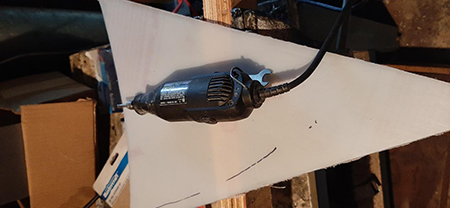
Using a cutoff disc.
Drilling plastic and wood and steel all require different bits. I have a drill sharpening attachment that I use to change the point angles on drill bits to almost flat, which reduces the tendency of twist drills to grab plastic sheets and damage them. The better hardware stores and Aircraft Spruce do carry dedicated drill bits for this. The plastic polycarbonate sheet I used does not crack, at least not readily, so I didn't bother. It also helps to use a drill press as much as possible.
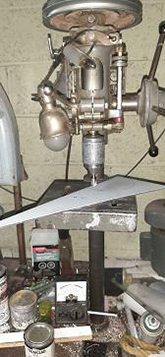
Using my sensitive drill press.
There are drill presses and drill presses. I bought one at a machine shop auction during the last recession. It is called a sensitive drill press. It only drills to ¼ inch deep, but it has a solid tool steel table about ¾ inch thick. One use is that if you've ever used #80 drill bits to make air bleed holes in motorcycle hand brakes, it's hard to do with anything else. A sensitive drill press turns at say 25000 rpm, and you need that to drill sizes #60-80. I used it a few times on this job. Friends said I'd never use it, but it sees service often. It's lovely to use, drills smoothly, and at 25000 no vibration exists.
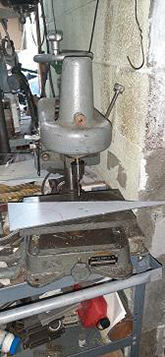
If you must drill with a handheld electric drill, use a block of wood to back up the material you are drilling. The ¼-inch hole in my thumb reminds me of the need for small blocks of wood. "No, Virginia, it only hurts the first day."
When you enlarge a windscreen for height, the bottom and front side retain the same angle, but the aft side angle becomes less acute. You can see that in the photos. I lengthened the frame for the front or four-sided pane by forming 6061 strips first into an angle and then closing the angle over a scrap of Lexan to form a channel. This was used for the aft side of the left and right front panes.

The work in progress.
The aft side of the frame was also fabricated from 6061 strips, but they are two strips formed into two say 30-degree angles, between which the clear sheet is sandwiched. It was necessary to add say six flush machine screws to lengthen each part. It used mostly 8-32 countersunk screws and nuts with Nylok inserts.
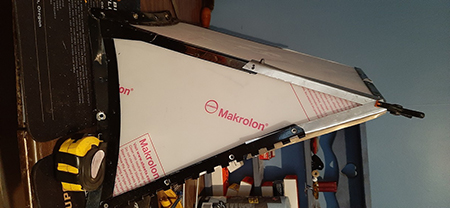
Side view of those lengthened channels.
I fabricated those bent strips to lengthen the frame, say, from 1½-inch-wide strips. You fit them for length, brake them to the angle, and then drill them on the press. Once you have them assembled, you'll see where they are too wide. Then you mark them, remove them, and trim them to size on your band saw or tip snips and deburr. If they distort in cutting, place ½-inch pieces of board or plywood in your vise and tighten. Each strip requires this twice.
The Sides
Amazingly, the two hinged side panes could be reworked to be used again. The sides are installed to the same hinges, but the hinges are at a different angle. With the windscreen installed with, say, two fasteners, the hinges could be installed and the new locations for the camlocks located to the fuselage side and door, then drilled and camlocks reinstalled. Once the camlocks are installed, say, 2 inches from the bottom of the hinged side panes, then you can start planning the top. Why a top, you ask? It is true that at the right airspeed, if you fly through rain the wing diverts the rain so that the pilot doesn't get wet. But if you care to fly faster or slower than rain speed, you need something over your head to block rain and reduce air turbulence.
Conversely the camlock receptacles for the top pane cannot be installed at this point, because the position of the side panes must be finalized first and the camlocks for the sides installed. Truth is the side panes are installed one or two slots lower in the hinges to permit the camlocks to fit. In consequence that must be finalized before the top can be installed with its camlocks. Why, you ask, is the top tilted up as it is, why not level? Less drag that way. The pilot's seat is placed so that the pilot can just see the corners of the runway at the edges of the windscreen. I'm not willing to give up that smallest glimpse of what I'm about to land on, and I wear a leather helmet and headset. That headset takes up say a inch above my head and I want another inch headspace just in case the air is choppy. It appears that even with an 18" windscreen I need the top tilted upwards 2 inches to provide the headroom I need. It may not be as much as the photo below indicates.
It may be possible to trim the top pane down a bit on the sides, but I won't know that until it's fitted.
It rained hard the next day so the new windscreen wasn't fitted until the following day. The center section goes on first with camlocks, then the sides, which use hinges and camlocks at the bottom.
The top pane is tricky. First you install the hinge pin then get in to determine the height. I used plastic clamps to locate it. At that point the top pane can be marked for drilling for a camlock on each side. That was done on the hangar work table and it went well. I've had to buy 2 new camlocks as the existing ones are too short. It will be a week until they arrive. Camlocks are sort of specialty fasteners. One supplier sells them for $7. My usual supplier asks $27 each. Enough said.
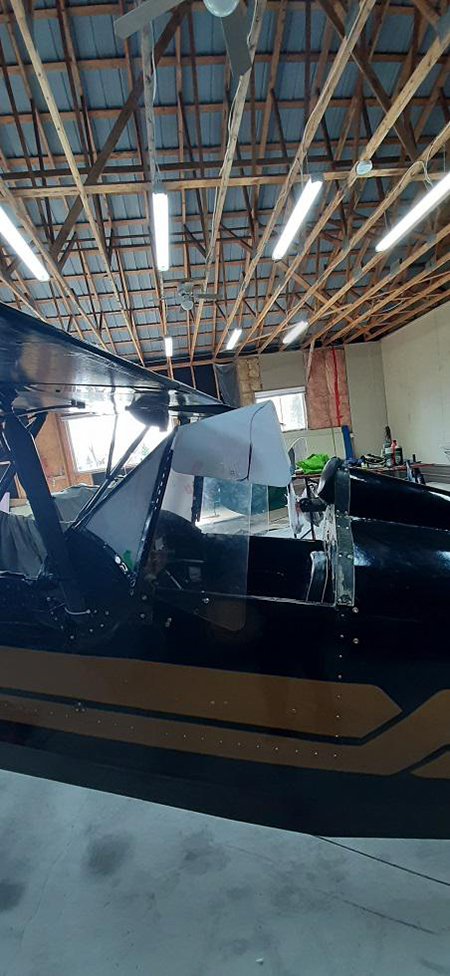
The more-or-less finished job.
This little installation brings up an important point in homebuilding. Many items you can save hundreds or thousands on by building parts yourself. Second, in almost every part of building, sequence of operations is essential. If you drill that top pane before you fit the rest to the fuselage and climb in, the top pane will either hit your head or hit the wing.
I find this little project to be enjoyable and its challenges manageable. In the months of COVID-19, the world is trying to occupy itself. Homebuilders have a ready opportunity to redeem all this otherwise wasted time. Tomorrow I start recovering the flight controls for the Sonerai. How about you?
